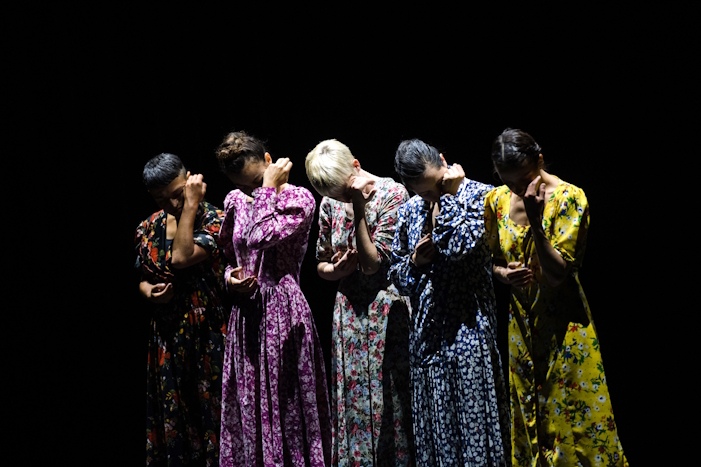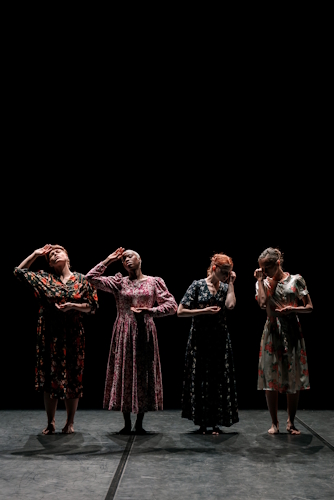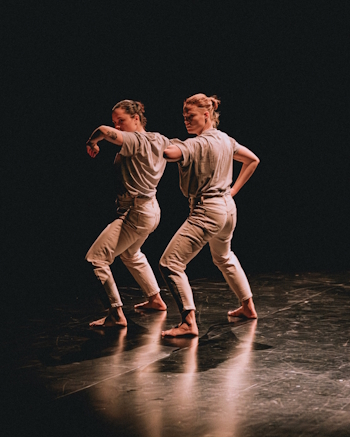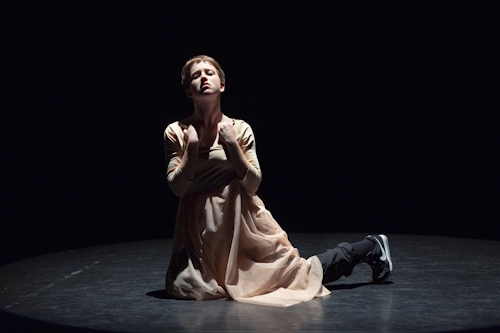Media Theater, ZKM, Karlsruhe
November 16, 2025
(presented by Tempel Kulturzentrum as part of the Tanz Karlsruhe festival)
Still only in her early-thirties, French choreographer Leïla Ka is one of the most in-demand dance makers in France, her company having the sort of extensive touring schedule most can only dream of. London audiences might remember her from Maldonne, an entry in the Bloom Prize section of the 2025 Rose International Dance Prize competition at Sadler’s Wells.
She has made her name with dance is full of combative energy. Presented at Karlsruhe’s ZKM (Centre for Art and Media, whose mission is to continue the classical arts into the digital age, and well worth a visit in its own right), all three works on this Triptyque programme of shorter pieces were astoundingly theatrical and precise.
Created in 2022, the lights go up on the 15-minute Bouffées to reveal Mathilde Roussin, Aïda Ben Hassine, Mariana Faria, Salomé Moro and Inès Lopez standing in a line. Looking down, they very slowly wipe their tear-stained cheeks. With each in an old-fashioned, calf-length dress, they could have come straight out of a Pina Bausch classic.
Hands are they raised to foreheads, palms open, the other hand against their pulled in stomachs. Quite what has caused the emotion is unclear. The programme note simply describes a ‘grief’ that they seek to transform into “a medium of power and revival.” That it is present is unarguable, though.
As the dance of arms and elbows develops and picks up speed, becoming ever more sudden, it doesn’t just move up and down the line, it ricochets here and there, seemingly at random but clearly very structured and carefully thought out, and all to the rhythm of their very audible breathing (one translation of ‘bouffée’ is ‘breath’). Falls to the floor come with loud thuds. They get up and fall again. Repeated, repeated. Again, the mind drifts back to Bausch.
Throughout, the dancers are clearly individual, yet equally clearly share whatever they are going through. They are women who have much to say, but who must do so without words. Perhaps they cannot find the words, so bodies must suffice. One certainly senses their self-doubt and insecurity.
Bouffées ends unresolved. While it works in its present form, it’s also one of those rarities, a piece that could, maybe should, be taken further.
Predating Bouffées, You’re the One We Love (C’est toi qu’on adore) has a similar movement vocabulary but takes things much further. A 25-minute duet, danced here by Moro and Lopez, the more stationary moments echo the theatricality and imagery of Maguy Marin’s May B, in which Leïla Ka has performed. But things really get exciting when the choreography adds in sudden driving twists, turns and travel around the stage.
Moro and Lopez were absolutely outstanding. One senses a determination to keep going whatever. Their movement was razor sharp, their togetherness in the numerous unison moments quite remarkable, especially given the speed of the movement. And the way the pair consistently came to a sudden stop was seriously impressive too.
For the most part, there is no music, at least in the conventional manner. Instead, the dancers make their own as hands, limbs, backs, whole bodies, thud against the floor. The effort is tremendous.
The evening closed the Pode ser (‘Could it be’ in Portuguese), the solo that brought Leïla Ka to prominence in 2018. A solo, it sees Mariana Faria in a dress worn over a pair of black tracksuit bottoms in an angry dance that speaks about the roles we play, chosen by ourselves and others.
Contrast and dichotomy abound, not only in costuming. The movement not only features hip-hop and contemporary, but moments straight from the street. There’s the occasional ballet step. The music flips between smooth classical and electronic ‘noise’. But it’s not so much a fusion as a collision. The movement itself suggests trying to break free. Someone trying to find their way, who they are, maybe.
Pode ser struggles to maintain the same pull as the other two works, though. You can do so much more structurally with two or more dancers than with one.
Put together, Triptyque paints a super picture of Leïla Ka’s style, one that pulls together hip-hop and various contemporary dance influences in quite a unique way. Her choreography is sharply incisive and precise, requires great core strength and physicality, but also leaves plenty of space for vulnerability. And let’s not forget the intense theatricality. Presently an associate artist at CENTQUATRE, Paris and Dieppe Scène Nationale, she’s an artist I think we may hear a lot more of.




